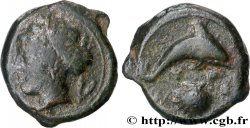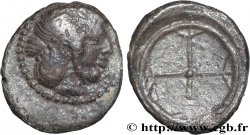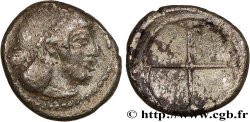v57_0037 - SICILY - SYRACUSE Tetras
MONNAIES 57 (2013)
Starting price : 145.00 €
Estimate : 250.00 €
Realised price : 145.00 €
Number of bids : 1
Maximum bid : 160.00 €
Starting price : 145.00 €
Estimate : 250.00 €
Realised price : 145.00 €
Number of bids : 1
Maximum bid : 160.00 €
Type : Tetras
Date: c. 415-405 AC.
Mint name / Town : Syracuse, Sicile
Metal : bronze
Diameter : 14,5 mm
Orientation dies : 9 h.
Weight : 1,73 g.
Rarity : R2
Coments on the condition:
Exemplaire sur un petit flan irrégulier, bien centré des deux côtés. Beau portrait d’Aréthuse de trois quarts de face, inhabituel pour le bronze. Revers stylisé. Jolie patine vert olive foncé, légèrement granuleuse
Catalogue references :
Obverse
Obverse description : Tête d’Aréthuse de trois quarts de face à droite, les cheveux flottants retenus par l’ampyx.
Reverse
Reverse description : Poulpe, vue de dessus.
Commentary
Poids léger. La série avec la tête d’Aréthuse de trois quarts de face est la plus rare des émissions avec le poulpe au revers. La collection de l’American Numismatic Society ne recèle que quatre exemplaires de cette rare variante, tous légers (de 1,71 g à 1,95 g). Cette pièce est décrite dans les ouvrages comme un tétras, au vue des poids, il faut plutôt y voir une onkai .
Light weight. The series with the three-quarter obverse view of the Arethusa head is the rarest of the issues with the octopus on the reverse. The American Numismatic Society's collection contains only four examples of this rare variant, all light (from 1.71 g to 1.95 g). This coin is described in the works as a grouse, but given the weight, it should be considered an onkai.
Light weight. The series with the three-quarter obverse view of the Arethusa head is the rarest of the issues with the octopus on the reverse. The American Numismatic Society's collection contains only four examples of this rare variant, all light (from 1.71 g to 1.95 g). This coin is described in the works as a grouse, but given the weight, it should be considered an onkai.








 Report a mistake
Report a mistake Print the page
Print the page Share my selection
Share my selection Ask a question
Ask a question Consign / sell
Consign / sell
 Full data
Full data










